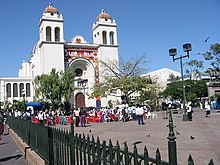
The Federal Republic of Central America, initially known as the United Provinces of Central America, was a sovereign state in Central America that existed between 1823 and 1839/1841. The republic was composed of five states, and a Federal District from 1835 to 1839. Guatemala City was its capital city until 1834, when the seat of government was relocated to San Salvador. The Federal Republic of Central America was bordered on the north by Mexico, on the south by Gran Colombia and on its eastern coastline by the Mosquito Coast and British Honduras, both claimed by the federal republic.
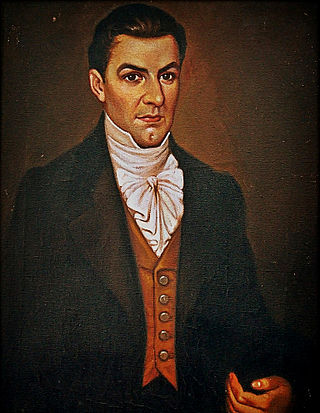
Manuel José Arce y Fagoaga was a Salvadoran statesman and military officer who served as the first president of the Federal Republic of Central America from 1825 to 1829.

José Matías Delgado y de León was a Salvadoran priest and doctor known as El Padre de la Patria Salvadoreña.
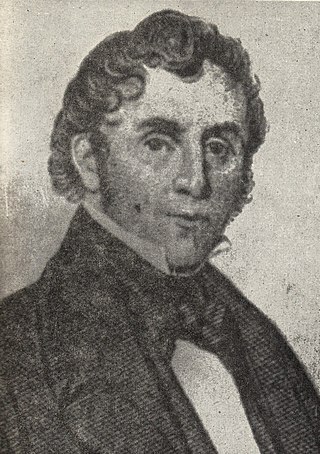
Juan Vicente Villacorta Díaz was a Central American politician. From July 10, 1823, to March 15, 1824, he was a member of the triumvirates that governed the Federal Republic of Central America. From December 13, 1824, to November 1, 1826, he was head of state of El Salvador, while it was a state of the Central American Federation.

Pedro Ortiz de la Barriere Castro was a Spanish politician, military officer, and lawyer who served as the colonial intendant of the Intendancy of San Salvador from 1819 until 1821. He also served the first head of state of the Province of San Salvador after the signing of the Act of Independence of Central America from September to November 1821. He was killed in action at the Battle of Milingo during the First Central American Civil War.
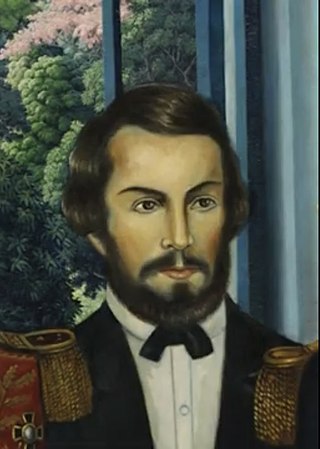
Juan Manuel Rodríguez was a Salvadoran revolutionary against Spain and later president of the State of El Salvador within the Federal Republic of Central America.
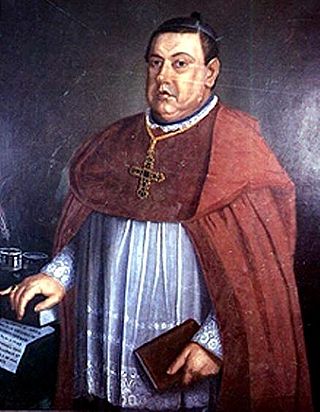
Juan José de Aycinena y Piñol was an ecclesiastical and intellectual conservative in Central America. He was President of the Pontifical University of San Carlos Borromeo from 1825 to 1829 and then of the Universidad Nacional from 1840 to 1865. He was a thinker criticized by liberal historians for his strong relationship with the conservative government of General Rafael Carrera and for eliminating the possibility of getting the Central American Union which the Liberals wanted. His participation in the government has been assessed more objectively in research conducted between 1980 and 2010. He was heir in 1814 to the noble title of III Marquess of Aycinena, and bishop in partibus of Trajanopolis from 1859. He had a taste for law, oratorical talent and wrote over twenty works.

The Act of Independence of Central America, also known as the Act of Independence of Guatemala, is the legal document by which the Provincial Council of the Province of Guatemala proclaimed the independence of Central America from the Spanish Empire and invited the other provinces of the Captaincy General of Guatemala to send envoys to a congress to decide the form of the region's independence. It was enacted on 15 September 1821.

El Salvador–Spain relations are the current and historical relations between El Salvador and Spain. Both nations are members of the Association of Academies of the Spanish Language, Organization of Ibero-American States and the United Nations.

The First Central American Civil War was a civil political and military conflict within the Federal Republic of Central America which lasted from 1827 until 1829. The civil war was fought between Liberal and Conservative lines with Francisco Morazán leading the Liberals and Manuel José Arce, a former Liberal, leading the Conservatives.

The Colonial Intendant of San Salvador was a political position created in 1786 to govern the Intendancy of San Salvador, modern-day El Salvador, that was a part of the Captaincy General of Guatemala, which itself was a part of the Viceroyalty of New Spain, a Spanish colony. The position was abolished on 21 September 1821 with the independence of Central America.

The Intendancy of San Salvador was an administrative division of the Captaincy General of Guatemala, itself an administrative division of the Viceroyalty of New Spain which was a part of the Spanish Empire.
Antonio Basilio Gutiérrez y Ulloa was a Spanish politician and bureaucrat. He held various offices in Spain, San Salvador, New Spain, and Mexico. His most notable political office was being the Colonial Intendant of the Intendancy of San Salvador from 1805 until he was deposed in the 1811 Independence Movement. Unlike other Spanish colonial administrators, Gutiérrez y Ulloa held no military background.

The Mayor of San Salvador is the head of the municipal government of the city of San Salvador, the capital city of El Salvador.

José Alejandro de Aycinena y Carrillo was a Spanish military officer and politician who served as the Colonial Intendant of the Intendancy of San Salvador from 1811 to 1812.

From January 1822 to July 1823, the Captaincy General of Guatemala, a former Spanish colony, was controlled by the First Mexican Empire, and briefly, the Supreme Executive Power—the provisional government that succeeded Mexican imperial rule. The captaincy general consisted of the provinces of Chiapas, Costa Rica, El Salvador, Guatemala, Honduras, and Nicaragua—the six southernmost provinces of the Mexican Empire. The incorporation of Central America brought Mexico to the height of its territorial extent.
The Consultive Junta was the government of Central America from its declaration of independence from the Spanish Empire on 15 September 1821 until its dissolution on 21 February 1822. The junta was led by Guatemalan General Gabino Gaínza.

Central America was a unified nation at several points throughout its history, and while united, the country has used several national flags. The design of the Central American flag, a blue and white horizontal triband, was inspired by the flag of Argentina.
The Battle of San Salvador was the action that concretized the Mexican annexation of El Salvador, it occurred on February 9 when Vicente Filísola enters San Salvador waving the imperial flags and assuming the command of head of state.
The Capitulation of Gualcince occurred during the Mexican annexation of El Salvador, on February 21, 1823, when Vicente Filísola after occupying San Salvador continued with a division and forced him to surrender his weapons and surrender.



